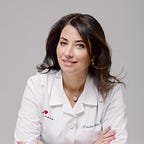A Year Of Treating COVID-19 — a Review from my Internal Medicine Practice
It has been my biggest pride and luck at the same time — not to lose a single patient to COVID-19 since I treated my first patient on March 17th of 2020. Shortly after the pandemic hit the US and the country went on lockdown, sick patients started coming into my New Jersey clinic. Today marks one year since the day when one of my patients showed up in the office with an acute respiratory illness, which turned out to be COVID-19 pneumonia. Since then, like thousands of other physicians around the world, I studied the way the pandemic affected various populations and used any available means to help my patients. It has been by far the most stressful year in close to twenty years of my professional career. Trying not to succumb to fear, keeping an open and critical mind to possible treatments, coupled with some luck of course, helped us get through the past three hundred and sixty five days with no deaths in the patients that I treated. Here is a brief overview of what transpired.
In March of 2020, we successfully implemented Telemedicine operations and were able to serve our patients without interruptions. PPE shortages, lockdowns and curfews were real and significant obstacles to healthcare delivery then. However, virtual visits allowed me to continue treating my patients and to provide care far beyond the intensity of regular outpatient appointments. Sick patients were monitored closely, sometimes several times throughout the day, to ensure that we do not miss the critical point of rapid decline in oxygen saturation leading to respiratory distress and intubation. I strived to have as many patients as possible monitor their vital signs at home, including their blood pressure, heart rate, temperature and oxygen saturation. We tested patients for coronavirus with nasal and pharyngeal swabs, saliva samples and were amongst the first ones to use a private laboratory to test for covid antibodies, well before it was widely available. I believe it helped quarantining measures, thereby preventing the community spread in our local area.
As an Internist who embraces Functional and Integrative Medicine approach, I had used various supplements and vitamins in my practice well before the pandemic. That allowed me to recommend the vitamins and supplements as supportive treatment of sick patients and as a preventative strategy for healthy patients early on. Using a personalized approach, I would choose from a long list, including but not limited to now well-known ones, such as Zinc, vitamin D, vitamin C, Vitamin A, quercetin, melatonin, etc. In addition, I used every method available to me which I could justify by doing a literature search and weighing out the pros and the cons for each case, including the antimalarials, antiparasitics, antibiotics, inhaled and oral steroids as well as supplemental oxygen. None of my patients died or suffered significant side effects with the treatments we provided.
As we survived the first and the second wave without any of the treated patients dying, I started asking myself a question: was I simply lucky or was there a pattern? Was my population healthier than average or was there a common denominator? My observation tells me that I might have had several advantages specific to my practice. Even prior to the pandemic, I had been optimizing levels of vitamin D and other micronutrients in my patients. Correlation between vitamin D deficiency and morbidity with COVID-19 has been well documented in several studies in the past year. Maybe, my patients had a higher than average serum level of this important hormone-like vitamin. In addition, as an Obesity specialist, I was working on achieving healthy weights in my patient population, while controlling diabetes, hypertension and cardiac risk factors, which all proved to be major risk factors for severity and worse outcomes with covid. I believe that close patient monitoring, even virtual in most of the cases, with the ability to institute treatment at home and hospitalize timely have also been a factor for positive outcomes in the patients I treated.
I will forever remember my patient Maryann. At the age of 99, she is the oldest patient in my practice who survived covid. Several months ago she suffered a cardiac event, for which she was hospitalized and released home. A few days later, she contracted COVID-19 from her family members, required hospitalization again for COVID pneumonia and was successfully treated. Lucky? Probably. But I would like to think that while the world has been awaiting for the vaccine rollouts and for the herd immunity to take place, an evidence based and personalized treatment of covid at early stages, allowed me to help every single one of them, as well as to be a part of their journey to surviving covid. One terrifying and life altering year and no deaths from covid in the patients which I have treated, — for that, I feel humbled and eternally grateful.
Double Boarded in Internal and Obesity Medicine
www.astraMDhealth.com
New Jersey, USA
